Complete Solutions to Revision Exercises (Short Answer Questions) of chapter DUAL NATURE OF RADIATION AND MATTER of Class 12 book with complete answers and questions
| Class 12 | PHYSICS |
| Chapter | DUAL NATURE OF RADIATION AND MATTER |
| MODERN PUBLICATION | Revision Exercises (Short Answer Questions) |
| Number Of Questions | 35 |
| Academic Year | 2023-24 |
Maximum kinetic energy of the photoelectrons is independent of the intensity of incident radiation .
Give reason.
View Solution(a) Define the terms , (i) threshold frequency and (ii) stopping potential in photoelectric effect.
(b) Plot a graph of photocurrent versus anode potential for a radiation of frequency v and intensities `I_1 and I_2`.
`(I_1 lt I_2)` .
View Solution(a) State the laws of photoelectric emission.
View SolutionDefine 'threshold frequency ' and ' work function ' of a metal . Show that de Broglie wavelength associated with a moving particle is `lamda=h/(mv)` , where the symbols have their usual meanings
View SolutionIf the work function of two metals X and Y are 4.17 eV and `8.24xx10^(-19)` J respectively , then for which metal lesser amount of energy will be required to emit an electron ?
View SolutionThe stopping potential `(v_0)` varies linearly with the frequency (v)of the incident radiation for a given photosensitive surface with the slope remaining the same for different surface . Given reason.
View SolutionWhen light off frequency `v_1` is incident on a photosensitive surface , the stopping potential is `V_1` . If the frequency of incident radiation becomes `v_1//2` the stopping potential changes to `V_2` Find out the expression for the threshold frequency for the surface in terms of `V_1 and V_2`
If the frequency of incident radiation is doubled , will the maximum kinetic energy of the photoelectrons also be doubled ? Given reason .
View SolutionLight of intensity I and frequency `nu` is incident on a photosensitive surface and causes photoelectric emission. What will be the effect on anode current when (i) the intensity of light is gradually increased, (ii) the frequency of incident radiation is increased and (iii) the anode potential is increased? In each case, all other factors remains the same. Explain, giving justification in each case.
View Solution(a) What is photo electric effect ? State the laws of photo - electric emission.
(b) Show that de - Broglie wavelength of electron when accelerated through a potential difference V is given by the relation -
`lamda=(12.27)/sqrtVÅ` , where V is in volt.
View SolutionThe maximum kinetic energy of photoelectron is doubled when the wavelength of light incident on the photosensitive changes from `lambda_1` to `lambda_2`. Deduce expression for the threshold wavelength and work function for metals in terms of `lambda_1` and `lambda_2`
View SolutionDerive de Broglie wave equation for material particles.
(b) Why does photoelectric emission not take place if the frequency of incident radiation is less than threshold frequency ?
View SolutionThe following graph shows the variation of photoelectric current for a photosensitive metal .

(a) Identify the variable X on the horizontal line.
(b) What does the point A on the horizontal axis represent?
(c) Draw this graph for three different values of frequencies of incident radiation `v_1, v_2 and v_3 (v_1gtv_2gtv_3)` for same intensity.
(d) Draw this graph for three different values of intensities of incident radiation `I_1,I_2,I_3 (I_1gtI_2gtI_3)` having same frequency.
View Solution(b) Calculate de Broglie wavelength for an electron moving with a speed of `10^(6)" m s"^(-1)`.
View SolutionThe graph shows variation of stopping potential `V_(0)` versus frequency of incident radiation `v` for two photosensitive metals `A` and `B`. Which of two metals has higher threshold frequency and why?
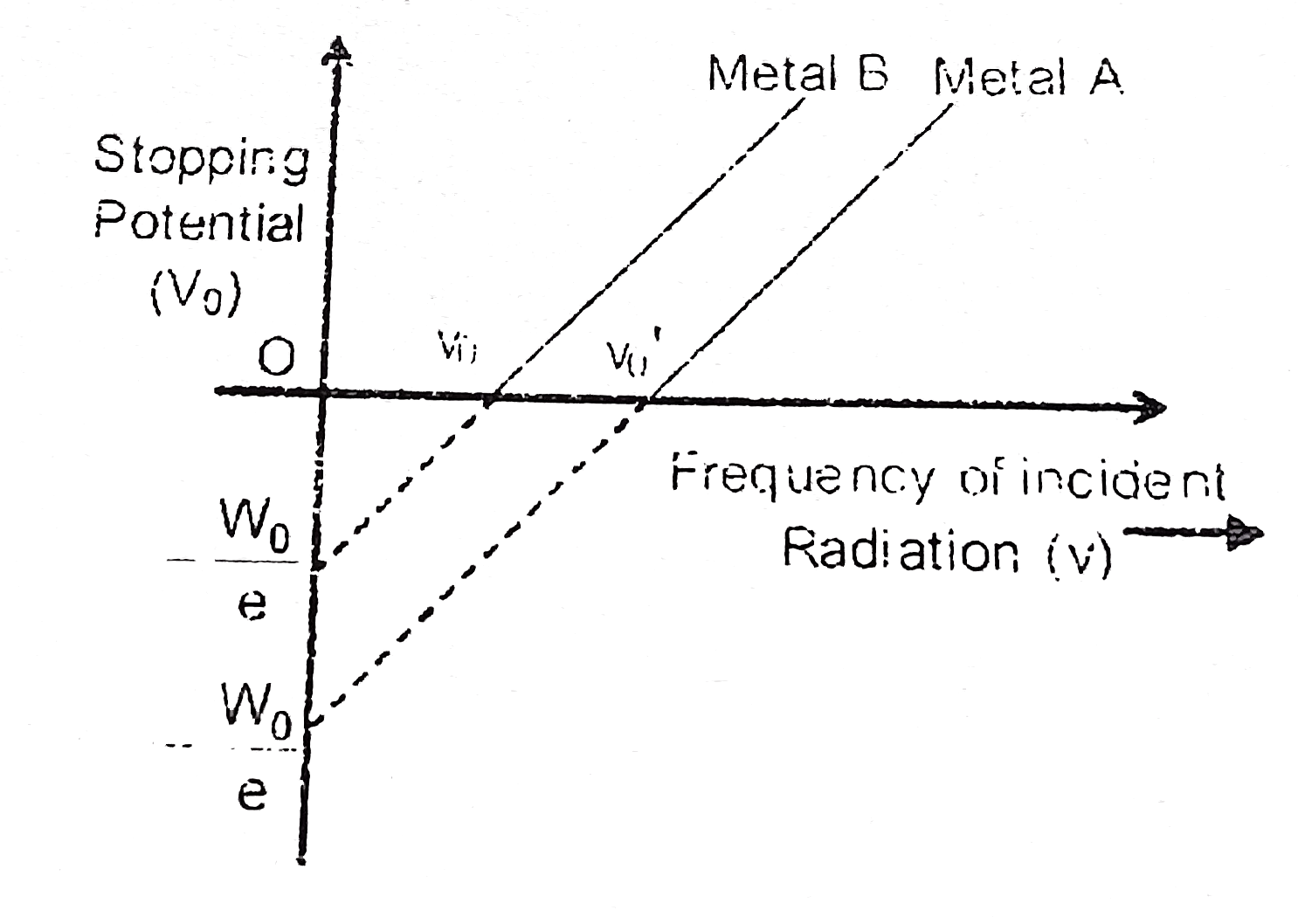
View SolutionDraw a plot showing the variation of photoelectric current with collector plate potential for two different frequencies, `v_1gtv_2` of incident radiation having the same intensity. In which case will the stopping potential be higher? Justify your answer.
View SolutionA proton and an alpha particle are accelerated through same potential Which one of the two has (i) greater value of de Broglie wavelength associated with it and (ii) less kinetic energy . Given reason to justify your answer (iii) Draw a plot showing the of incident radiation on a given photosensitive surface.
View SolutionIf an em wave of wavelength `lambda` is incident on a photosensitive surface of negligible work function. If the photoelectrons emitted from this surface have the de-Broglie wavelength `lambda_1`, prove that
`lambda=((2mc)/h)lambda_1^2`
View SolutionWrite the three characteristic features in photoelectric effect which cannot be explained on the basis of wave theory of light, but can be explained by using Einstein's equation.
View SolutionWhen a given photosensitive material is irradiated with light of frequency `nu`, and maximum speed of the emitted photoelectrons equals `v_(max)`. The square of `v_(max)`is observed to very with `v`, as per the graph shown in fig. Obtain expression for (i) Planck's constant and (ii) the work function of the given photosensitive material, in terms of the parameter `l`, `n` and the mass `m` of the electrons.
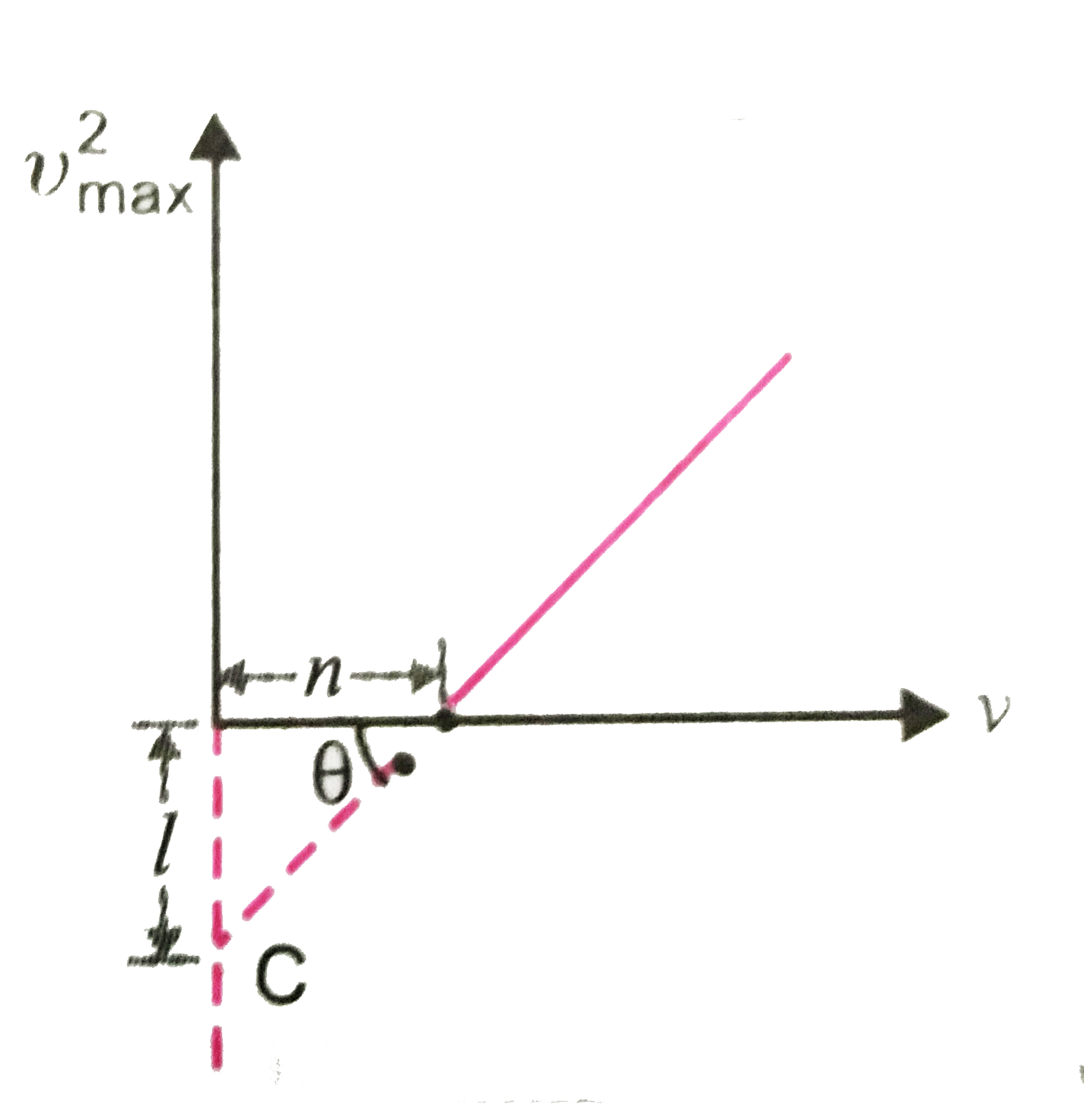
View SolutionDraw and explain the graph showing the variation of stopping potential with frequency of incident radiation in relation to photoelectric effect.
View Solution(a) State three important properties of photons which describe the particle picture of electromagnetic radiation.
(b) Use Einstein's photoelectric equation to define the terms (i) stopping potential and (ii) threshold frequency.
View SolutionIn a plot of photoelectric current versus anode potential, how does
(i) the saturation current vary with anode potential for incident radiations of different frequencies but same intensity?
(ii) the stopping potential vary for incident radiations of different intensities but the same frequency?
(iii) Photoelectric current vary of different intensities but same frequency of incident radiation? justify your answer is each case.
View Solutionfig. shows variation of stopping potential `(V_0)` with frequency (v) for two photosensitive materials `M_1 and M_2`.
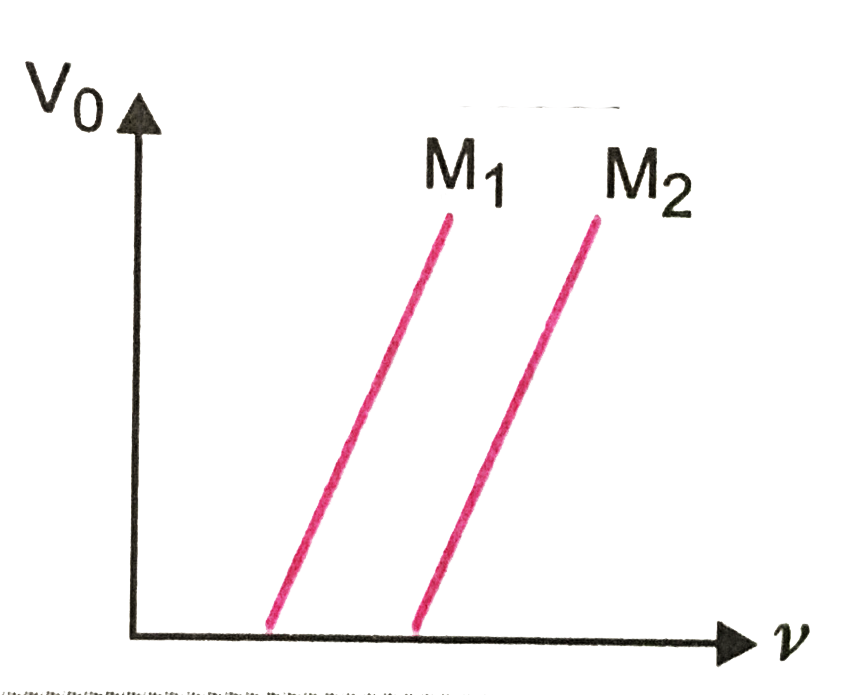
(i) why is the slope same for both lines?
(ii) For which material will the emitted electrons have greater kinetic energy for the incident radiations of the same frequency? Justify your answer.
View Solution(i) How does one explain the emission of electron from a photosensitive surface with te help of Einstein's photoelectric equation ?
(ii) The work function of the following metals is given : `Na = 2.75 eV, K = 2.3 eV, Mo = 4.17 eV` and `Ni = 5.15 eV`. Which of these metals will not cause photoelectric emission for radiation of wavelength `3300 Å` from a laser source placed 1 m aways from these metals ? What happens if the laser source is brought nearer and placed 50 cm away ?
View SolutionPlot a graph showing variation of de-broglie wavelength `lambda` versus `1//sqrtV`, where V is accelerating potential for two particle A and P carrying same charge but of masses `m_1 and m_2(m_1gtm_2)`. Which one of the two represents a particle of smaller mass and why?
View SolutionA proton and deutron are accelerated through the same accelerating potential. Which one of the two has (a) greater value of de-broglie wavelength associated with it, and (b) less momentum? Give reasons to justify your answer.
View SolutionDerive an expression for the de Broglie wavelength associated with an electron accelerated through a potential V. Draw a schematic diagram of localised .
View SolutionA proton and an `alpha`-particle are accelerated through same potential difference. Find the ratio of their de-Brogile wavelength.
View SolutionA photon and an elecron have the same de Broglie wavelength. Which has greater total energy? Explain
View SolutionKinetic energy of proton is the same as that of an `alpha`-particle. What is the ratio of their respective de Brogile wavelengths?
View SolutionIn the study of a photoelectric effect the graph between the stopping potential V and frequency `nu` of the incident radiation on two different metals P and Q is shown in fig.
(i) which one of two metals have higher threshold frequency
(ii) Determine the work function of the metal which has greater value
(iii) Find the maximum kinetic energy of electron emitted by light of frequency `8xx10^(14) Hz` for this metal.
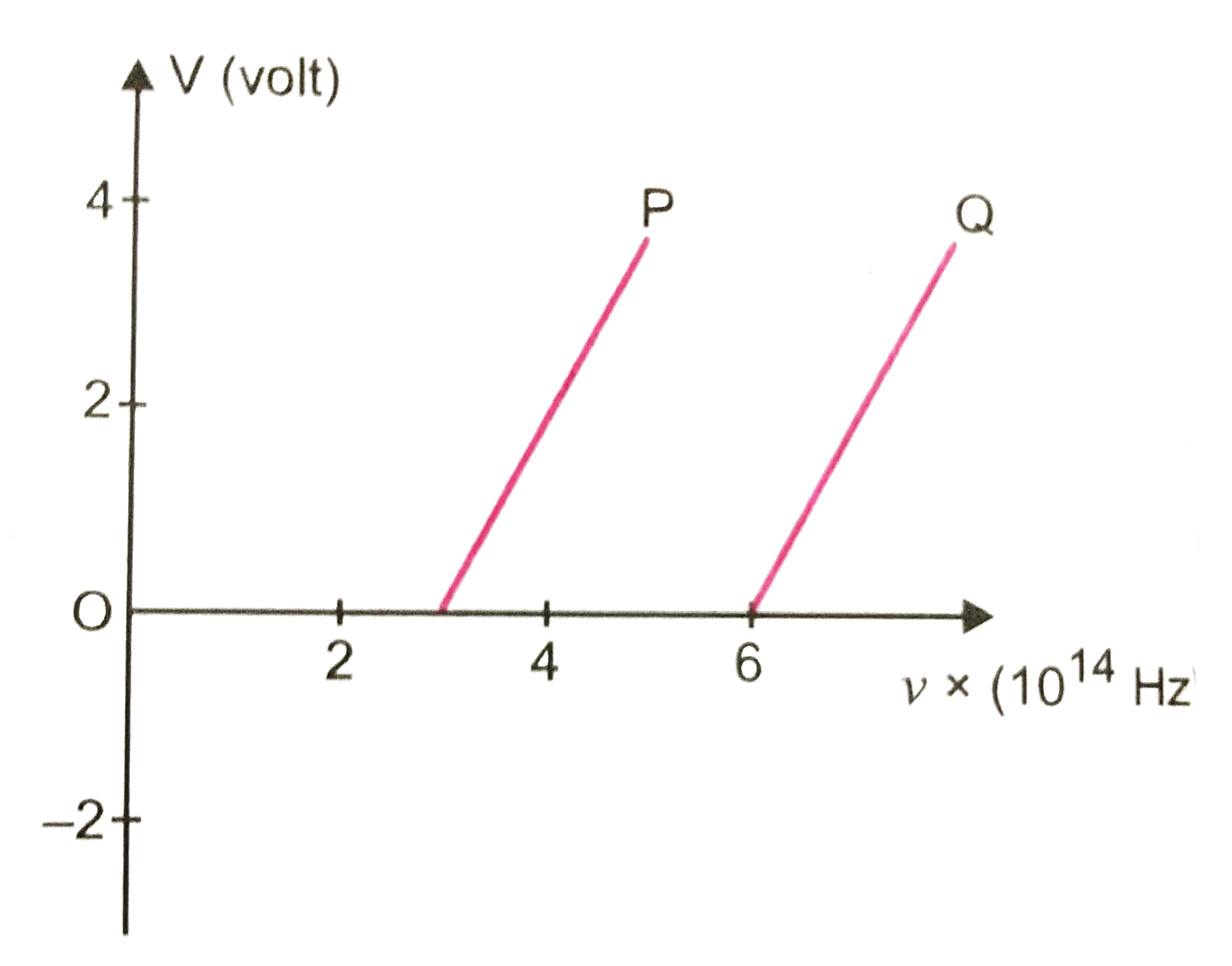
View SolutionExplain the term stopping potential and threshold frequency.
View SolutionThe given graph shows the variation of KE with frequency of incident radiations for two surfaces A and B.

(a) Which of the metals has greater work function ? For which of the metals will stopping potential be more for the same frequency of incident radiation ?
(b) The work function caesium metal is 2.14 eV. When light of frequency `6xx10^(14)` Hz. incident on the metal surface , what is the maximum KE of the photoelectrons and stopping potential ?
View SolutionHow does Davisson and Germer's experiment verify the wave nature of electrons ?
View SolutionIf light of wavelength 412.5 nm is incident on each of the metals given below, which one will show photoelectric emission and why? .
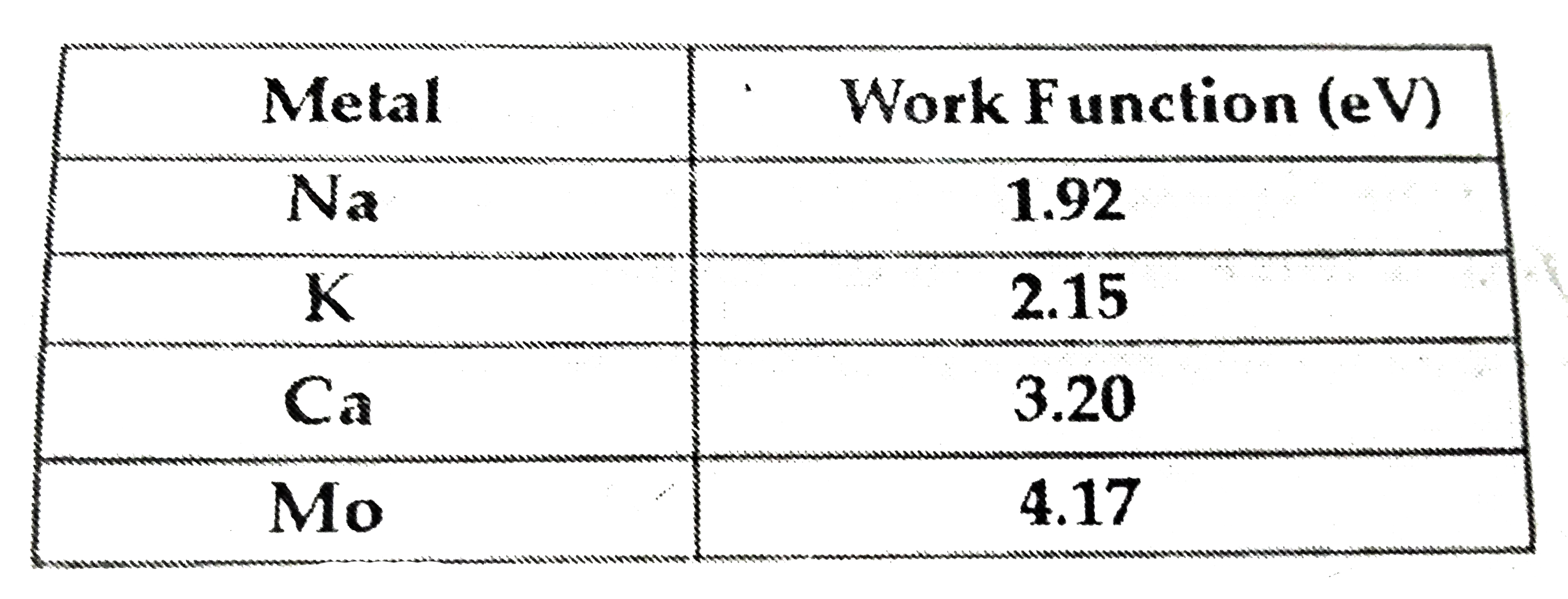
View Solution
Revision Exercises (Short Answer Questions) questions and complete solutions for chapter DUAL NATURE OF RADIATION AND MATTER of MODERN PUBLISHERS PHYSICS (HINGLISH) of Class 12
All Exercises from MODERN PUBLICATION Class 12 PHYSICS DUAL NATURE OF RADIATION AND MATTER
- CHAPTER PRACTICE TEST
- COMPETITION FILE (OBJECTIVE TYPE QUESTIONS ( A - Multiple Choice Questions))
- COMPETITION FILE (OBJECTIVE TYPE QUESTIONS ( B - Multiple Choice Questions) (AIPMT/NEET & Other State Boards for Medical Entrance))
- COMPETITION FILE (OBJECTIVE TYPE QUESTIONS ( B - Multiple Choice Questions) (JEE (Advanced) for IIT Entrance))
- COMPETITION FILE (OBJECTIVE TYPE QUESTIONS ( B - Multiple Choice Questions) (JEE (Main) & Other State Boards for Engineering entrance))
- COMPETITION FILE (OBJECTIVE TYPE QUESTIONS ( C - Multiple Choice Questions) )
- COMPETITION FILE (OBJECTIVE TYPE QUESTIONS ( D - Multiple Choice Questions) )
- COMPETITION FILE (OBJECTIVE TYPE QUESTIONS (ASSERTION REASON TYPE QUESTIONS))
- COMPETITION FILE (OBJECTIVE TYPE QUESTIONS (INTEGER TYPE QUESTIONS))
- COMPETITION FILE (OBJECTIVE TYPE QUESTIONS (MATCHING TYPE QUESTIONS))
- COMPETITION FILE (OBJECTIVE TYPE QUESTIONS (MATRIX MATCH TYPE QUESTIONS))
- Conceptual Questions
- Higher Order Thinking Skills & Advanced Level (QUESTIONS WITH ANSWERS)
- NCERT FILE (NCERT - Additional Exercises)
- NCERT FILE (Textbook Exercises)
- NCERT FILE (NCERT - Exemplar Problems - Objective Questions (Multiple Choice Questions (Type - I)))
- NCERT FILE (NCERT - Exemplar Problems - Objective Questions (Multiple Choice Questions (Type - II)))
- NCERT FILE (NCERT - Exemplar Problems - Subjective Questions (Short Answer Type Questions))
- NCERT FILE (NCERT - Exemplar Problems - Subjective Questions (Very Short Answer Type Questions))
- PRACTICE PROBLEMS - 1
- PRACTICE PROBLEMS - 2
- PRACTICE PROBLEMS - 3
- Revision Exercises (Additional Questions)
- Revision Exercises (Fill in the Blanks)
- Revision Exercises (Long Answer Questions)
- Revision Exercises (Numerical Problems)
- Revision Exercises (Short Answer Questions)
- Revision Exercises (Very Short Answer Questions)
- SOLVED EXAMPLES
- Tough & Tricky PROBLEMS